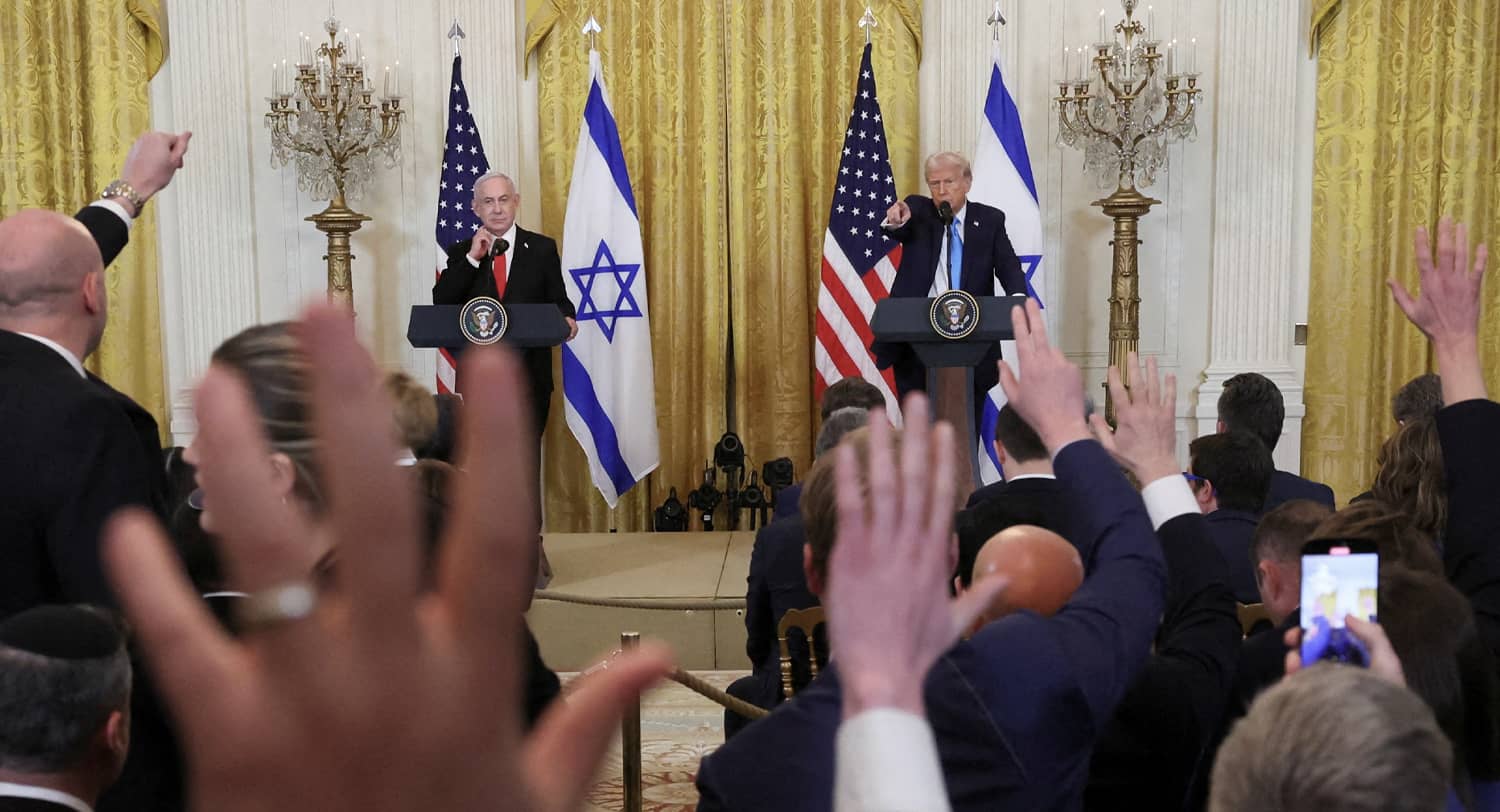President Donald Trump has enhanced his reputation for unpredictability in foreign policy with his novel suggestion, at a joint press conference with Israeli prime minister Benjamin Netanyahu, that the people currently living in the Gaza Strip be evacuated and that the United States assume control of that territory and rebuild it. The president is surely correct that continuing the previous arrangements in Gaza, with the Islamic fundamentalist terrorist organization Hamas in charge, will only lead to more terror, death, destruction, and misery. Something new is certainly needed.
What the President has proposed undoubtedly qualifies as thinking outside the box; but for it to come to pass, others would have to engage in similarly unorthodox thinking, and at this point that is not likely. The people now living in Gaza are unlikely to leave; even if they wanted to do so, no country in the region appears willing to receive them; nor is any country likely to supply the policing needed to ensure that Hamas does not retain its grip there; and American taxpayers would probably balk at contributing to the reconstruction of Gaza, even in the unlikely event that it were both empty and secure. All these parties have strongly held reasons for their preferences, which efforts at persuasion by the Trump administration will have difficulty in overcoming.
It is worth noting, however, that if current trends continue, Hamas will reassert itself, meaning that no funds for reconstructing Gaza will be forthcoming. Moreover, as the terrorist organization seeks to rearm and launch attacks against Israel, the Israelis, determined not to make the mistake that made possible the attack and slaughter of October 7, 2023, will respond forcefully. Conditions in Gaza will deteriorate even further. After, say, a year of this, perhaps the Trump proposal won’t seem as implausible as it does at present.
Since the Trump initiative attracted immediate condemnation from governments and individuals around the world, it is also worth noting that many of those who have objected strenuously to the idea of displacing the Gazans have had no compunction about giving aid and comfort, rhetorically and financially, directly and indirectly, to groups such as Hamas that seek to do precisely that to Israeli Jews. There is, of course, a difference between the two cases: under Trump’s proposal, the Gazans would presumably leave peacefully, whereas Hamas and its ilk seek to accomplish their goal by murdering Israelis, as they demonstrated on October 7, 2023.
Still, the Trump administration will undoubtedly have a major impact on two other Middle Eastern issues, both of greater long-term importance than the future of Gaza, issues that were also raised at the press conference: the Iranian nuclear weapons program and the prospects for a Palestinian state. The precise impact is unpredictable for both issues because the President has goals involving each that are not necessarily compatible, indeed are perhaps even contradictory
On Iran, Mr. Trump has resumed the policy of maximal economic pressure that he adopted during his first term in office and that the Biden administration eased. Such pressure has as its major purpose preventing the Islamic Republic from pushing its nuclear program, which is already on the verge of making bombs, to the point at which the country actually has a nuclear arsenal ready to attack other Middle Eastern countries.
At the press conference, Mr. Trump stated categorically that Iran will not be allowed to complete its nuclear quest. Yet he also expressed interest in negotiations with the Iranian government. “I say to Iran who is listening intently, I would love to be able to make a great deal, a deal where you can get on with your lives.” This attitude opens door for Iranian-American talks which, if they should get under way, would hold two dangers.
The Iranian regime could string out the talks by stalling, and use the time it thereby bought to complete its march to the bomb. It would then present the United States, the Middle East, and the world with a nuclear fait accompli. Even in the absence of an all-out rush to nuclear-weapon status, any agreement with Iran would have to satisfy the United States and other countries that the Iranian mullahs had shut down their nuclear program. That, in turn, would require an unprecedentedly rigorous and intrusive regime to inspect the country’s nuclear facilities. Such a regime would not be easy to design or to operate; and good-faith compliance by the Iranian government could not be presumed.
If the American government were not satisfied with Iranian conduct once negotiations were launched, or after an agreement was concluded, it would retain, in theory, the option of stopping the nuclear program with attacks on the nuclear facilities from the air, either directly by American forces or indirectly through approving and assisting an Israeli attack. Whether President Trump would be willing to authorize a strike of either kind is far from clear. Logically, to keep Iranian non-nuclear he should be doing everything possible to persuade the decision-makers in Tehran that if they take the wrong path they will pay heavily. Instead, he has delivered the contrary message. On his Truth Social platform, he said that “reports that the US, working in conjunction with Israel, is going to bomb Iran into smithereens ARE GREATLY EXAGGERATED.”
On the Palestinian question, a succession of American presidents, going back decades, has held two convictions: first, that its resolution – which all of them came to believe entailed creating a Palestinian state – was imperative for the peace of the region and American interests there; and second, that establishing such a state was eminently feasible. Both propositions were and are false.
Middle Eastern governments have expressed rhetorical solidarity with the Palestinians but have demonstrated repeatedly that their policies are geared to their own interests and that the future of the Palestinians is not among them. The absence of a Palestinian state has not crippled American policy in the region. In addition, no Palestinian state has come into being because the Palestinians themselves don’t want one. They have repeatedly turned down offers of such a state and never stipulated the conditions in which they would accept one. They prefer to continue their decades-long campaign to destroy Israel, a campaign of which the Hamas attack and atrocities of October 7, 2023, was only the latest episode.
To his credit, President Trump has shown no sign of sharing the erroneous if persistent beliefs of his predecessors, but he risks getting bogged down in the Palestinian question all the same. For one of his highest goals, reiterated in his press conference with Prime Minister Netanyahu, is to make peace between Israel and Saudi Arabia by including the Saudis in the Abraham Accords he helped to bring into being at the end of his first term. The Saudis, however, have said that the necessary condition for them to join the Accords is progress, of an unspecified kind, toward a Palestinian state. Since a Saudi-Israeli peace agreement would be the crowning achievement of Trump’s Middle East diplomacy, he has a powerful incentive to pursue it; but doing so could once again ensnare him and the United States in a futile effort to establish such a state.
All apart from the ongoing lack of Palestinian interest in one, with the horrific experience of October 7 fresh in their minds, Israelis are not about to hand over territory to people who perpetrated that event, or celebrated it, or both. Thus, Trump risks getting trapped in a dead-end process that would expend his and America’s political capital for nothing.
In short, the President approaches two crucial Middle Eastern issues with conflicting impulses, indeed with two different foreign-policy personae: the tough and sturdy guarantor of America’s interests and allies, ready to use force to defend them, on the one hand; and the virtuoso deal-maker who can broker agreements where others have failed, on the other. Which will prevail in the Iranian and Palestinian cases? Stay tuned.

